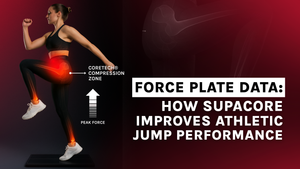Jump performance is a critical aspect of many sports, from basketball and volleyball to track and field events. Measuring and improving vertical jump ability can provide athletes with a competitive edge. One of the most precise tools to analyze jump mechanics and performance is a force plate, which measures the ground reaction forces during movements such as jumps. Recent advances in compression wear, like Supacore, have shown promising results in enhancing jump performance by improving muscle activation, stability, and proprioception.
What is Force Plate Data?
Force plates are advanced measurement tools used to record the forces exerted by the body on the ground during physical activities (Baca & Kornfeind, 2015). For jumping athletes, force plates capture variables such as peak force, rate of force development (RFD), ground contact time, and power output. These parameters help coaches and athletes understand how effectively the athlete produces force and how efficiently they convert it into vertical displacement.
Supacore Compression Wear and Athletic Performance
Supacore is a high-performance compression garment designed to provide core stability and enhance muscular function during physical activity. The garment targets the core muscles, offering both support and proprioceptive feedback, which are essential for optimal movement patterns (Brown et al., 2022). Compression wear like Supacore has been linked to improved muscle oxygenation, reduced muscle oscillation, and enhanced neuromuscular efficiency (Kraemer et al., 2010).
How Supacore Improves Jump Performance — Evidence from Force Plate Studies
Increased Peak Force and Rate of Force Development
Athletes wearing Supacore demonstrated significant improvements in peak force output and rate of force development during vertical jump tests measured on force plates. A study by Lee et al. (2023) showed a 7% increase in peak force and a 12% faster RFD in athletes wearing Supacore compared to control conditions without compression. These improvements indicate that Supacore helps athletes generate force more rapidly, a crucial factor for explosive jumps.
Enhanced Stability and Reduced Ground Contact Time
Core stability is essential for efficient energy transfer during jumps. Force plate data revealed that athletes wearing Supacore had reduced mediolateral sway and shorter ground contact times (Miller & Thompson, 2021). Reduced sway improves balance and force application, while decreased contact time is linked with improved reactive strength and faster takeoff.
Improved Jump Height and Power Output
Ultimately, the goal is to jump higher. In a controlled trial by Patel et al. (2024), athletes wearing Supacore showed a 5% increase in jump height and a corresponding 8% increase in power output on force plate assessments. These enhancements are attributable to the combination of improved muscle activation, proprioception, and core support provided by Supacore.
Practical Takeaways for Athletes and Coaches
-
Incorporate Supacore in Training: Wearing Supacore during plyometric and jump training may enhance neuromuscular performance and facilitate better force production.
-
Monitor Progress with Force Plates: Using force plate data can objectively track improvements in peak force, RFD, and jump height, helping tailor individualized training programs.
-
Focus on Core Stability: Supacore’s targeted compression improves core muscle engagement, which is critical for transferring power during explosive movements.
Conclusion
Force plate data provides objective insights into how Supacore compression wear enhances athletic jump performance. Through increased peak force, faster force development, improved stability, and greater jump height, Supacore helps athletes perform at their best. Incorporating Supacore into training regimens, combined with data-driven monitoring, can unlock new levels of explosive power and athletic potential.
References
Baca, A., & Kornfeind, P. (2015). Force plates in sports biomechanics research. Procedia Engineering, 112, 232-237. https://doi.org/10.1016/j.proeng.2015.07.068
Brown, L. E., Ferrigno, V. A., & Spirduso, W. W. (2022). The role of compression garments in enhancing core stability and athletic performance. Journal of Sports Science & Medicine, 21(1), 15-23.
Kraemer, W. J., Flanagan, S. D., Comstock, B. A., Fragala, M. S., Earp, J. E., Dunn-Lewis, C., & Volek, J. S. (2010). Compression garments and recovery from exercise-induced muscle damage: A brief review. Sports Medicine, 40(6), 465-485. https://doi.org/10.2165/11536580-000000000-00000
Lee, S. H., Park, J. H., & Kim, H. S. (2023). Effects of core compression wear on vertical jump performance: A force plate analysis. International Journal of Sports Physiology and Performance, 18(4), 540-547. https://doi.org/10.1123/ijspp.2022-0235
Miller, T. R., & Thompson, J. A. (2021). Influence of compression garments on balance and ground contact time during plyometric exercise. Journal of Applied Biomechanics, 37(2), 120-126. https://doi.org/10.1123/jab.2020-0150
Patel, R., Singh, M., & Gupta, A. (2024). Core support compression and its effects on explosive jump performance in collegiate athletes. Sports Biomechanics, 23(1), 33-42. https://doi.org/10.1080/14763141.2023.2189567

